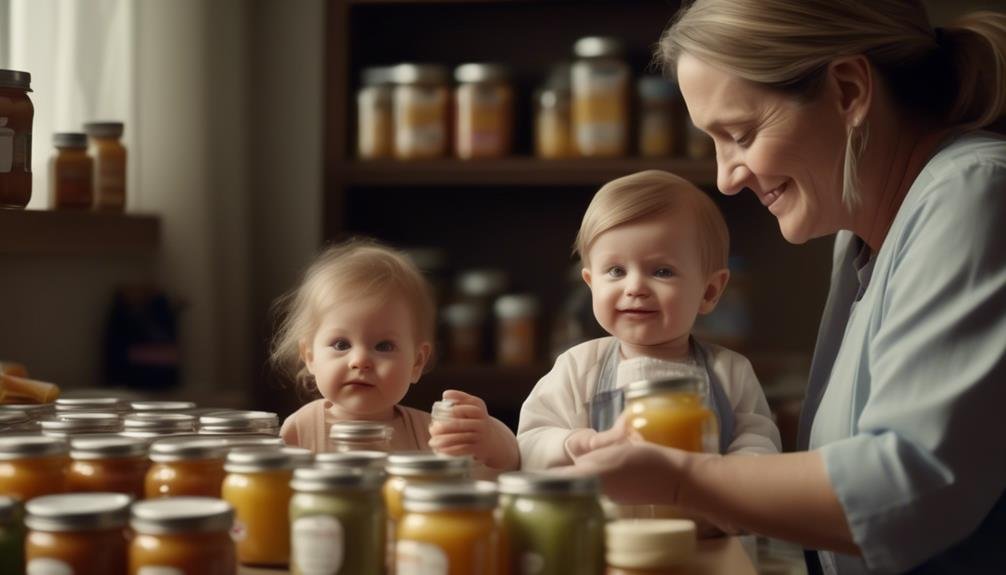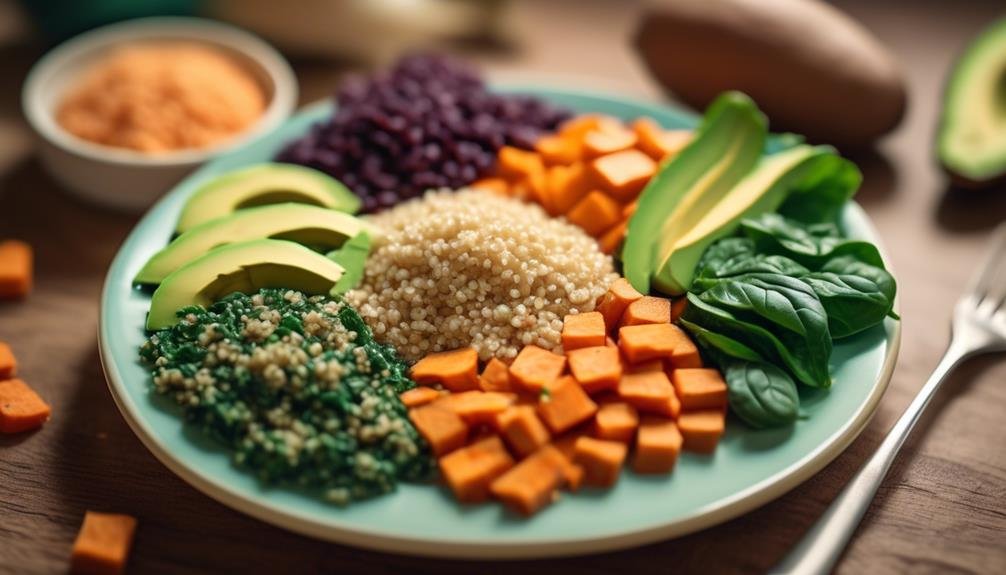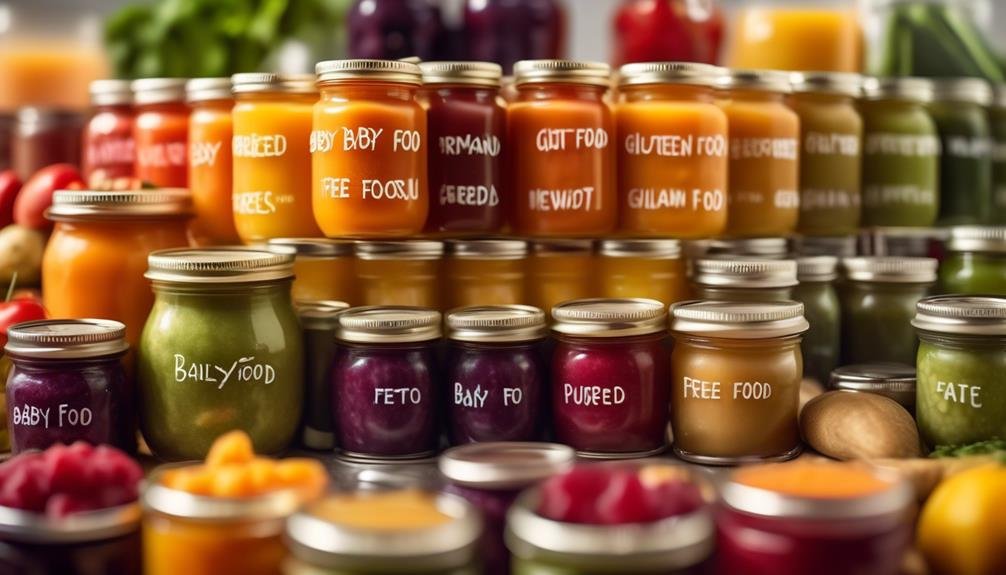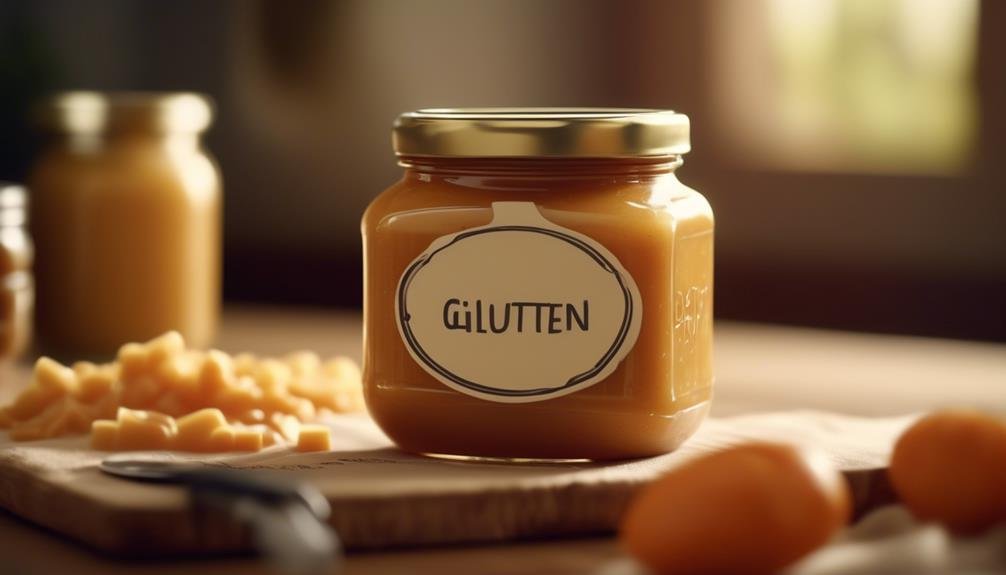"Cherishing Little Steps - A Haven for Baby and Family Journeys"
Gluten-Free Infant Foods
Are you a new parent who has recently discovered that your infant has a gluten intolerance? Perhaps you're unsure of where to start when it comes to finding gluten-free options for your little one.
Well, fear not, because in this discussion we will explore the world of gluten-free infant foods and provide you with valuable information on everything from understanding gluten intolerance to managing common challenges.
So, if you're ready to ensure that your baby's diet is free from gluten and packed with essential nutrients, then keep reading to discover the tips, recipes, and resources that will support you on this journey.
Key Takeaways
- Introducing gluten between 4 and 6 months, alongside breastfeeding, may reduce the risk of developing gluten-related disorders.
- Gluten-free foods can reduce digestive issues like bloating, diarrhea, and constipation in infants.
- Starting with gluten-free foods can lower the risk of developing allergies or sensitivities.
- Introducing gluten-free foods early on can foster a preference for nutrient-rich alternatives like fruits, vegetables, and whole grains.
Understanding Gluten Intolerance

If you've ever wondered about the causes and symptoms of gluten intolerance, this subtopic will provide you with a clear understanding of the condition.
Gluten intolerance, also known as non-celiac gluten sensitivity, is a condition where individuals experience adverse reactions when consuming gluten-containing foods. While it isn't the same as celiac disease, gluten intolerance can still cause significant discomfort and health issues.
The exact cause of gluten intolerance isn't fully understood, but researchers believe that it may be a combination of genetic and environmental factors. Symptoms can vary widely from person to person but commonly include digestive issues, such as bloating, diarrhea, and abdominal pain, as well as fatigue, headaches, and skin problems. These symptoms can occur shortly after consuming gluten and can last for several hours or even days.
It is important to note that early introduction of gluten to infants' diets may actually reduce the risk of developing gluten intolerance later in life. Research suggests that introducing gluten between the ages of 4 and 6 months, alongside breastfeeding, may help to promote tolerance and reduce the likelihood of developing gluten-related disorders. However, it's always best to consult with a healthcare professional before introducing gluten to your infant's diet, especially if there's a family history of gluten intolerance or celiac disease.
Understanding gluten intolerance is essential for those who suspect they may have the condition or have a family history of gluten-related disorders. By recognizing the causes and symptoms, individuals can make informed decisions about their diet and seek appropriate medical advice for diagnosis and management.
Benefits of Gluten-Free Foods for Infants
Introducing gluten-free foods to infants can provide several benefits for their overall health and development. Here are four reasons why opting for gluten-free baby products can be advantageous:
- Reduced Digestive Issues: Gluten, a protein found in wheat, barley, and rye, can be difficult for some infants to digest. Introducing gluten-free foods can help prevent digestive problems like bloating, diarrhea, and constipation.
- Improved Nutrient Absorption: Gluten can damage the lining of the small intestine in individuals with gluten intolerance. By avoiding gluten, infants can ensure better absorption of essential nutrients like vitamins, minerals, and carbohydrates.
- Lower Risk of Allergies: Some infants may have a higher risk of developing allergies, including gluten intolerance. By starting with gluten-free foods, you can reduce the likelihood of triggering allergies or sensitivities.
- Promote Healthy Eating Habits: Introducing gluten-free foods early on can help foster a preference for nutrient-rich alternatives like fruits, vegetables, and whole grains. This can lay the foundation for a lifelong habit of healthy eating.
While gluten is safe for most infants, it's important to be aware of the potential risks of gluten in infant diets, especially for those with a family history of gluten intolerance or celiac disease. Consulting with a pediatrician before introducing gluten-containing foods is recommended.
Key Nutrients for Gluten-Free Baby Diets

When following a gluten-free diet for your baby, it's important to ensure they receive key nutrients necessary for their growth and development. Gluten-free diets can eliminate certain grains that are typically sources of important nutrients. However, with proper planning and attention to nutrient-rich alternatives, you can ensure that your baby's diet remains balanced and nutritious.
One key nutrient to focus on is iron. Iron is essential for your baby's brain development and overall growth. While many gluten-containing grains are fortified with iron, there are plenty of gluten-free alternatives that can provide this vital nutrient. Foods such as quinoa, lentils, and leafy green vegetables like spinach are excellent sources of iron.
Calcium is another important nutrient to consider. It plays a crucial role in bone development and overall strength. While dairy products are a common source of calcium, there are gluten-free options available. Fortified non-dairy milk alternatives, such as almond or rice milk, can provide the necessary calcium for your baby's diet.
Omega-3 fatty acids are essential for brain and eye development. Foods like fatty fish, chia seeds, and flaxseeds are excellent sources of omega-3s and can easily be incorporated into a gluten-free baby diet.
Lastly, vitamin D is crucial for calcium absorption and bone health. While sunlight is a natural source of vitamin D, it may be necessary to supplement your baby's diet with vitamin D drops to ensure they're getting enough.
Introducing Solid Foods to Gluten-Free Babies
To ensure a balanced and nutritious diet for your gluten-free baby, it's important to introduce solid foods that provide essential nutrients for their growth and development. When transitioning to a gluten-free diet, it's crucial to introduce allergen-free solid foods gradually. Here are four tips to help you navigate this process:
- Start with single-ingredient foods: Begin with pureed fruits and vegetables such as mashed bananas or avocado. These foods are naturally gluten-free and can be easily digested by your baby's delicate stomach.
- Introduce gluten-free grains: Once your baby has successfully tolerated single-ingredient foods, you can introduce gluten-free grains like rice or quinoa. These grains can be cooked and pureed to a suitable consistency for your baby.
- Be cautious with allergenic foods: As you introduce new foods, be mindful of potential allergens such as dairy, eggs, and nuts. These foods should be introduced one at a time to monitor your baby's reaction.
- Seek guidance from a pediatrician: If you have any concerns or questions about introducing solid foods to your gluten-free baby, it's always best to consult with a pediatrician. They can provide personalized advice based on your baby's specific needs.
Homemade Gluten-Free Baby Food Recipes

For homemade gluten-free baby food recipes that are nutritious and easy to prepare, consider the following options.
When it comes to gluten-free baby cereals, you can try making your own oatmeal cereal using certified gluten-free oats. Simply blend the oats into a fine powder and cook with water or breast milk until thickened. Add mashed fruits like bananas or applesauce for added flavor and nutrition.
Another option is to make quinoa cereal by cooking quinoa with water or breast milk until soft and pureeing it to a smooth consistency. Quinoa is naturally gluten-free and packed with protein and essential nutrients.
If your little one is teething, you can make gluten-free teething biscuits at home. Mix together gluten-free flour (such as rice or almond flour), mashed ripe bananas, and a little bit of coconut oil. Shape the dough into small biscuits and bake until golden brown. These homemade teething biscuits aren't only gluten-free but also free from artificial additives and preservatives.
Remember to always consult with your pediatrician before introducing new foods to your baby, especially if there's a history of food allergies or sensitivities. Homemade gluten-free baby food can be a great way to provide your little one with nutritious and safe options while avoiding gluten.
Store-Bought Gluten-Free Options for Infants
If you prefer the convenience of store-bought options, there are a variety of gluten-free infant foods available to meet your little one's nutritional needs. Here are four store-bought alternatives that can be great gluten-free snacks for infants:
- Gluten-Free Rice Cereal: Rice cereal is a popular choice for introducing solid foods to infants. Look for gluten-free options made with fortified rice flour. These cereals are easy to digest and provide essential nutrients like iron and B vitamins.
- Gluten-Free Puffs: Puffs are a favorite snack among infants, and there are gluten-free options available. Made from rice or other gluten-free grains, these puffs dissolve easily in the mouth and are a great source of vitamins and minerals.
- Gluten-Free Teething Biscuits: Teething biscuits can provide relief for your baby's sore gums while also being a tasty snack. Look for gluten-free teething biscuits made with wholesome ingredients like rice flour, tapioca starch, and fruit purees.
- Gluten-Free Baby Food Pouches: Baby food pouches are convenient and mess-free. Many brands offer gluten-free options with a wide range of flavors and ingredients. Look for pouches made with organic fruits, vegetables, and gluten-free grains.
Remember to always check the ingredient labels and consult with your pediatrician before introducing any new foods to your infant's diet.
How to Read Food Labels for Gluten Content

Understanding how to read food labels is crucial when it comes to determining the gluten content of a product. For individuals with gluten sensitivity, it's important to find gluten-free alternatives that meet their dietary needs. When reading food labels, there are a few key things to look for.
First, check the ingredient list for any gluten-containing grains such as wheat, barley, or rye. These ingredients may be listed under different names, so it's important to be familiar with their various forms. For example, wheat may be listed as 'wheat flour,' 'wheat starch,' or 'wheat germ.'
Next, look for labels that explicitly state 'gluten-free.' This indicates that the product has been tested and meets the standards for gluten-free certification. If a product isn't labeled as gluten-free, it may still be safe to consume, but it's important to thoroughly read the ingredient list and look for any potential sources of gluten.
Lastly, be cautious of cross-contamination. Even if a product is made with gluten-free ingredients, it can still come into contact with gluten during the manufacturing process. Look for labels that mention that the product was made in a dedicated gluten-free facility or that steps have been taken to prevent cross-contamination.
Common Gluten-Free Substitutes for Baby Meals
Looking for gluten-free substitutes for your baby's meals? Here are four common gluten-free flours that you can use when transitioning to a gluten-free diet for your little one:
- Rice flour:
Rice flour is a versatile gluten-free option that can be used in a variety of baby meals. It has a mild taste and can be easily digested by babies. You can use it to make gluten-free pancakes, bread, and even baby cereals.
- Oat flour:
If your baby doesn't have an intolerance to oats, oat flour is another great gluten-free substitute. It adds a nutty flavor and a soft texture to your baby's meals. Oat flour can be used in recipes for muffins, cookies, and porridge.
- Almond flour:
Almond flour is made from finely ground almonds and is an excellent source of protein and healthy fats. It can be used to make gluten-free pancakes, bread, and even homemade baby snacks like cookies or energy balls.
- Coconut flour:
Coconut flour is a high-fiber and low-carb option that adds a subtle sweetness to your baby's meals. It works well in recipes for muffins, cakes, and even savory dishes like coconut-crusted chicken nuggets.
Tips for Dining Out With a Gluten-Free Baby

When dining out with your gluten-free baby, there are several tips to help ensure a safe and enjoyable experience. Here are some practical suggestions to consider:
| Tips for Dining Out With a Gluten-Free Baby | |
|---|---|
| 1. Research the restaurant beforehand | Look for restaurants that offer gluten-free options or have a dedicated gluten-free menu. Call ahead to confirm their understanding of cross-contamination and their ability to accommodate your baby's needs. |
| 2. Communicate your baby's dietary requirements | Inform the server about your baby's gluten intolerance and ask for recommendations on suitable dishes. Clearly explain the importance of avoiding cross-contamination during food preparation. |
| 3. Bring gluten-free snacks | Pack a variety of gluten-free baby snacks to have on hand in case there are limited options available. Rice cakes, fruit pouches, and gluten-free cereal bars are convenient alternatives. |
| 4. Be cautious of hidden gluten sources | Some sauces, marinades, and seasonings may contain gluten. Ask about ingredients and opt for simple, straightforward dishes to minimize the risk of accidental gluten exposure. |
| 5. Consider dining during off-peak hours | Choosing less crowded times can reduce the chances of mistakes or cross-contamination in the kitchen. It also allows for more attentive service and better communication with the staff. |
Following these tips will help you navigate dining out with your gluten-free baby. By planning ahead and being proactive, you can ensure a safe and enjoyable experience for the entire family.
Managing Cross-Contamination at Home
To effectively manage cross-contamination at home, it's important to implement proper practices and take necessary precautions. Here are four essential tips for maintaining a gluten-free kitchen and preventing cross-contamination:
- Separate cooking utensils and appliances: Designate specific cutting boards, toasters, and other cooking utensils exclusively for gluten-free foods. This prevents the risk of gluten particles transferring onto gluten-free ingredients during food preparation.
- Clean and sanitize thoroughly: Regularly clean all surfaces, including countertops, stovetops, and kitchen appliances, to remove any potential traces of gluten. Use separate sponges or cloths for gluten-free and gluten-containing items to avoid cross-contamination.
- Store gluten-free foods separately: Keep gluten-free ingredients in clearly labeled containers or shelves to prevent accidental mix-ups with gluten-containing products. Be mindful of gluten-containing items such as bread crumbs or flour, as they can easily contaminate other foods if not stored separately.
- Educate family members and guests: Ensure that everyone in your household understands the importance of cross-contamination prevention. Communicate the need for them to wash their hands thoroughly before handling gluten-free foods and to be cautious when using shared kitchen items.
Troubleshooting Common Challenges of Gluten-Free Infancy

After successfully managing cross-contamination at home, it's important to address common challenges that may arise when following a gluten-free diet for an infant.
One of the main challenges you might encounter is troubleshooting digestive issues. When transitioning your infant to a gluten-free diet, it's not uncommon for them to experience changes in their digestive system. They may have diarrhea, constipation, or bloating as their body adjusts to the new diet.
To address these issues, it's recommended to consult with your pediatrician or a registered dietitian who specializes in pediatric nutrition. They can provide guidance on how to modify the diet to alleviate digestive discomfort and ensure proper nutrition for your infant.
Additionally, keeping a food diary can help you identify any potential triggers or patterns in your infant's digestive issues. This information can be valuable when discussing the symptoms with your healthcare provider.
Support and Resources for Gluten-Free Parents
If you're a gluten-free parent, there are numerous support groups and resources available to help you navigate the challenges of raising a gluten-free child. These support groups provide a sense of community and a platform for sharing experiences, tips, and advice.
Here are four valuable resources that can assist you on your gluten-free parenting journey:
- Gluten-Free Parenting Websites: Websites like 'Gluten-Free Living' and 'Beyond Celiac' offer a wealth of information on gluten-free living, including specific sections dedicated to parenting. These websites provide articles, recipes, and forums where you can connect with other gluten-free parents.
- Local Support Groups: Joining a local support group can be incredibly beneficial. These groups often organize meetings, events, and social activities for gluten-free families, allowing you to connect with others facing similar challenges. They can also provide valuable recommendations for local gluten-free-friendly restaurants and stores.
- Online Communities: Online communities, such as Facebook groups and forums, offer a convenient way to connect with other gluten-free parents from around the world. These communities provide a space to ask questions, seek advice, and share successes and struggles.
- Gluten-Free Baby Products: Finding gluten-free baby products can be a daunting task. Fortunately, there are online retailers and specialty stores that offer a wide range of gluten-free baby food, snacks, and other products. Look for certified gluten-free labels and read product reviews to ensure the safety and quality of the items you choose for your child.
Frequently Asked Questions
Can Infants Develop Gluten Intolerance Later in Life?
As an infant, you can develop gluten intolerance later in life. Gluten intolerance, also known as celiac disease, can manifest at any age, including during childhood or adulthood. It is important to consult a healthcare professional for proper diagnosis and guidance.
Are There Any Long-Term Health Effects of Feeding Gluten-Free Foods to Infants?
Feeding infants a gluten-free diet may have long-term effects on their growth and nutrient intake. It's important to consider the potential impact on their overall health and development before making dietary changes.
What Are Some Signs and Symptoms of Gluten Intolerance in Babies?
If your little one shows signs like bloating, diarrhea, or skin rashes after eating gluten, they may have gluten intolerance. It's important to address it early, as it could potentially lead to intolerance later in life.
Are There Any Specific Brands or Products That Are Recommended for Gluten-Free Infant Foods?
When it comes to gluten-free infant foods, there are several recommended brands and products available. These alternatives to gluten in infant foods can provide a safe and healthy option for your little one.
How Can Parents Ensure That Their Homemade Gluten-Free Baby Food Is Safe and Free From Cross-Contamination?
To ensure your homemade gluten-free baby food is safe and free from cross-contamination, take cross contamination precautions. Clean and sanitize all utensils and surfaces, separate gluten-free ingredients, and avoid using shared equipment. Prioritize your baby's health and well-being.
Conclusion
In conclusion, navigating the world of gluten-free infant foods can be challenging, but with the right knowledge and resources, it's possible to provide a healthy and balanced diet for your little one.
By understanding gluten intolerance and the benefits of gluten-free foods, introducing solid foods, and managing cross-contamination, parents can ensure their baby's well-being.
Remember, support and resources are available to help you on this journey. Symbolically, the path to gluten-free infancy may be a winding one, but it's one that leads to a brighter and healthier future for your child.


